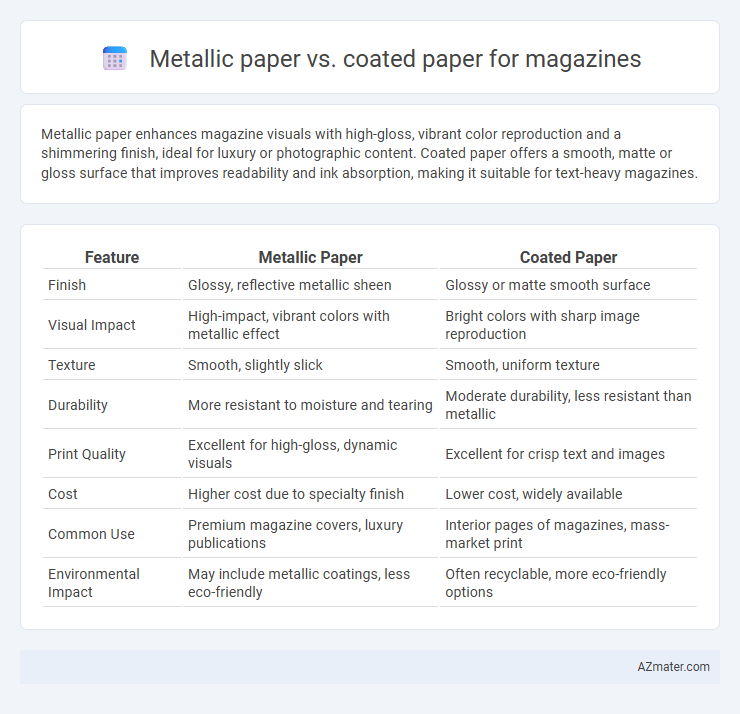Metallic paper enhances magazine visuals with high-gloss, vibrant color reproduction and a shimmering finish, ideal for luxury or photographic content. Coated paper offers a smooth, matte or gloss surface that improves readability and ink absorption, making it suitable for text-heavy magazines.
Table of Comparison
| Feature | Metallic Paper | Coated Paper |
|---|---|---|
| Finish | Glossy, reflective metallic sheen | Glossy or matte smooth surface |
| Visual Impact | High-impact, vibrant colors with metallic effect | Bright colors with sharp image reproduction |
| Texture | Smooth, slightly slick | Smooth, uniform texture |
| Durability | More resistant to moisture and tearing | Moderate durability, less resistant than metallic |
| Print Quality | Excellent for high-gloss, dynamic visuals | Excellent for crisp text and images |
| Cost | Higher cost due to specialty finish | Lower cost, widely available |
| Common Use | Premium magazine covers, luxury publications | Interior pages of magazines, mass-market print |
| Environmental Impact | May include metallic coatings, less eco-friendly | Often recyclable, more eco-friendly options |
Introduction to Magazine Printing Papers
Metallic paper enhances magazine printing by delivering a glossy, reflective finish that amplifies color vibrancy and sharpness, ideal for high-impact visuals and luxury publications. Coated paper, available in gloss, matte, or silk finishes, offers smooth surfaces that improve ink absorption and image clarity, balancing cost-effectiveness with quality reproduction. Choosing between metallic and coated papers depends on the desired aesthetic, print durability, and budget constraints in magazine production.
What is Metallic Paper?
Metallic paper features a shiny, reflective surface with a pearlescent finish that enhances images with vibrant colors and a high-gloss effect, making it ideal for premium magazines and luxury branding. Unlike coated paper, which has a smooth, matte or glossy finish that controls ink absorption for crisp text and images, metallic paper offers a unique metallic sheen that adds depth and a tactile experience to printed materials. This type of paper is often chosen for high-impact magazine covers or inserts where visual appeal and color intensity are crucial.
What is Coated Paper?
Coated paper, commonly used in magazine printing, features a smooth surface achieved by applying a layer of coating materials such as clay or calcium carbonate, enhancing ink hold and color vibrancy. This coating improves print quality, reduces ink absorption, and produces sharper images and text compared to uncoated paper. Metallic paper, by contrast, contains a reflective layer that delivers a glossy, shimmering effect, making coated paper preferable for vibrant, high-resolution magazine layouts requiring crisp detail without the metallic shine.
Visual Appeal: Shine vs Sheen
Metallic paper delivers a high-gloss, mirror-like shine that dramatically enhances images with vivid color depth and eye-catching brilliance, ideal for magazines aiming to captivate readers. Coated paper offers a subtler, smooth sheen that provides a refined, sophisticated finish, ensuring text and photos maintain clarity with less glare. Choosing metallic paper intensifies visual impact, while coated paper balances elegance and readability for magazine layouts.
Color Reproduction and Vividness
Metallic paper enhances color reproduction with its unique pearlescent finish, delivering highly vivid and striking images ideal for magazines emphasizing vibrant visuals. Coated paper, typically gloss or matte, offers consistent color accuracy and sharpness but lacks the reflective quality that boosts depth and brilliance in metallic papers. For magazines prioritizing eye-catching imagery and dynamic contrast, metallic paper provides superior luminosity and color intensity compared to standard coated paper.
Texture and Tactile Experience
Metallic paper offers a smooth, glossy texture with a reflective finish that enhances vibrant colors and provides a luxurious tactile experience, making images appear more dynamic in magazines. Coated paper features a silky, smooth surface with a matte or glossy finish that reduces glare and offers a subtle, refined feel ideal for text readability and photo clarity. The choice between metallic and coated paper significantly influences magazine aesthetics and reader engagement through their distinct tactile sensations.
Print Compatibility and Performance
Metallic paper offers superior print compatibility for magazines requiring vibrant, high-gloss finishes with enhanced color saturation and sharp image detail, making it ideal for premium visuals. Coated paper, typically gloss or matte, ensures smooth ink absorption and consistent print performance while providing versatility for various print methods such as offset and digital printing. Both papers support high-resolution images, but metallic paper excels in creating eye-catching effects, whereas coated paper delivers reliable color accuracy and faster drying times for large print runs.
Cost Comparison: Metallic vs Coated
Metallic paper generally incurs higher production costs due to its unique reflective finish and specialized manufacturing processes compared to coated paper, which is more widely produced and economically efficient. Coated paper's availability in gloss, matte, and silk finishes offers cost flexibility, making it a budget-friendly choice for mass-market magazines. Choosing metallic paper elevates printing expenses significantly but delivers a premium visual impact, often justifying the added investment for high-end publications.
Sustainability and Environmental Impact
Metallic paper contains a thin layer of metal or metallic pigments that enhance visual appeal but complicate recycling due to mixed materials and potential chemical residues. Coated paper, often clay or latex-based, offers improved print quality with better recyclability and biodegradability, making it a more sustainable choice for magazine production. Lifecycle assessments indicate coated paper generally has a lower environmental impact, supporting eco-friendly publishing practices through reduced resource consumption and waste generation.
Best Use Cases for Each Paper Type
Metallic paper enhances vibrant, high-contrast images, making it ideal for magazines featuring photography, fashion, and luxury products where visual impact is crucial. Coated paper offers a smooth finish with excellent ink holdout, best suited for magazines with extensive text, detailed graphics, or mixed content requiring sharp clarity and readability. Choosing the right paper depends on the magazine's content style and audience, with metallic paper boosting visual appeal and coated paper ensuring versatile, professional presentation.

Infographic: Metallic paper vs Coated paper for Magazine
 azmater.com
azmater.com